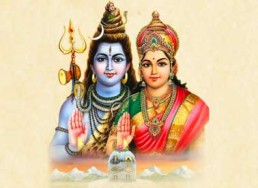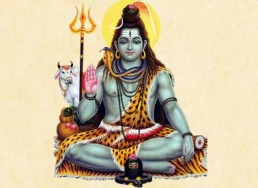Kamakshi Stotram
कान्तां कञ्जदलेक्षणां कलिमलप्रध्वंसिनीं कालिकाम् ।
काञ्चीनूपुरहारदामसुभगां काञ्चीपुरीनायिकां
कामाक्षीं करिकुम्भसन्निभकुचां वन्दे महेशप्रियाम् ॥ १॥
k͟hāntām k͟han.ja_ḍale[a-īi]kssannām k͟hali_ṃala_Pradhvamsinīm k͟hālikām |
k͟hān.cī_ṇūpura_ḥāra_ḍāma_Subhagām k͟hān.cī_Purī_ṇāyikām
k͟hāmākssīm k͟hari_k͟humbha_Sannibha_k͟hucām Vande ṃaheśa_Priyām ||1||
who is beautiful with eyes like the lotus petals, and at the same time terrible in the form of devi Kalika, the destroyer of the sins of Kali-Yuga,
who is beautifully adorned with girdles, anklets, garlands and wreath, and brings good fortune to all as the goddess of Kanchi puri,
whose bosom is beautiful like the forehead of an elephant and is filled with compassion; we extol devi Kamakshi, the beloved of Sri Mahesha.
चन्द्रार्कानललोचनां सुरुचिरालङ्कारभूषोज्ज्वलाम् ।
ब्रह्मश्रीपतिवासवादिमुनिभिः संसेविताङ्घ्रिद्वयां
कामाक्षीं गजराजमन्दगमनां वन्दे महेशप्रियाम् ॥ २॥
Candra-ārka-ānala_l̤ocanām Surucira-ālangkāra_Bhūsso[a-ū]jjvalām |
Brahma_ṣrīpati_Vāsava-[ā]adi_ṃunibhih Samsevita-āngghri_ḍvayām
k͟hāmākssīm ġaja_ṟāja_ṃanda_ġamanām Vande ṃaheśa_Priyām ||2||
whose three eyes are the sun, moon and the fire; and who adorned with radiant Ornaments is blazing luminous,
whose holy pair of feet is served by lord Brahma, lord Vishnu, Indra and other devas, as well as the great Sages,
whose movement is gentle like the king of elephants; we extol devi Kamakshi, the beloved of Sri Mahesha.
वाचां आदिमकारणं हृदि सदा ध्यायन्ति यां योगिनः ।
बालां फालविलोचनां नवजपावर्णां सुषुम्नाश्रितां
कामाक्षीं कलितावतंससुभगां वन्दे महेशप्रियाम् ॥ ३॥
Vācām āadima_k͟hārannam ḥrdi Sadā ḍhyāyanti ẏām ẏoginah |
Bālām Phāla_Vilocanām ṇava_Japā_Varnnām Sussumna-[ā]aśritām
k͟hāmākssīm k͟halita-āvatamsa_Subhagām Vande ṃaheśa_Priyām ||3||
who is the primordial cause of the speech itself, and who is meditated upon by the Yogis in the cave of their hearts,
who is worshipped in the form of Bala Tripurasundari (form of a small girl) who is having an eye on her forehead and having the colour of fresh hibiscus flower; she dwells in the Sushumna,
who is adorned with garlands and brings good fortune to all; we extol devi Kamakshi, the beloved of Sri Mahesha.
विश्वं तत् परिपाति विष्णुरखिलं यस्याः प्रसादाच्चिरम् ।
रुद्रः संहरति क्षणात् तद् अखिलं यन्मायया मोहितः
कामाक्षीं अतिचित्रचारुचरितां वन्दे महेशप्रियाम् ॥ ४॥
Viśvam ṭat Paripāti Vissnnur-ākhilam ẏasyāh Prasādāc-Ciram |
ṟudrah Samharati k͟hssannāt ṭad ākhilam ẏan-ṃāyayā ṃohitah
k͟hāmākssīm āti_Citra_Cāru_Caritām Vande ṃaheśa_Priyām ||4||
by whose perennial grace, Sri Vishnu protects the entire world,
(and) Rudra destroys in a moment that whole (creation) which is deluded by the power of Maya.
whose deeds are diverse and lovely; we extol devi Kamakshi, the beloved of Sri Mahesha.
वीक्षाशिक्षितराक्षसां त्रिभुवनक्षेमङ्करीं अक्षयाम् ।
साक्षाल्लक्षणलक्षिताक्षरमयीं दाक्षायणीं सक्षिणीं
कामाक्षीं शुभलक्षणैः सुललितां वन्दे महेशप्रियाम् ॥ ५॥
Vīkssā_ṣikssita_ṟākssasām ṭri_Bhuvana_k͟hssemangkarīm ākssayām |
Sākssāl[t]-l̤akssanna_l̤akssita-ākssara_ṃayīm ḍākssāyannīm Sakssinnīm
k͟hāmākssīm ṣubha_l̤akssannaih Su-l̤alitām Vande ṃaheśa_Priyām ||5||
the Knowledge of whose essence refines the rakshasas (demons within signifying evil tendencies) and gives Undecaying rest within the three worlds,
whose imperishable essence can be directly experienced in meditation; who is Dakshayani (born as the daughter of Daksha) and the underlying witness of everything,
who is marked with auspicious attributes and is ever playful; we extol devi Kamakshi, the beloved of Sri Mahesha.
आम्नायाम्बुधिचन्द्रिकां अधतमःप्रध्वंसहंसप्रभाम् ।
काञ्चीपट्टणपञ्जराऽऽन्तरशुकीं कारुण्यकल्लोलिनीं
कामाक्षीं शिवकामराजमहिषीं वन्दे महेशप्रियाम् ॥ ६॥
āamnāya-āmbudhi_Candrikām ādha_ṭamah_Pradhvamsa_ḥamsa_Prabhām |
k͟hān.cī_Pattttanna_Pan.jara-āantara_ṣukīm k͟hārunnya_k͟hallolinīm
k͟hāmākssīm ṣiva_k͟hāmarāja_ṃahissīm Vande ṃaheśa_Priyām ||6||
who is the illumination behind the four sacred texts (four Vedas) destroying even the most evil sins and revealing the light of the hamsa (the universal soul) within,
who is like a parrot caged within the city of Kanchi from whom is surging out the waves of compassion,
who is the queen of Sri Shiva; that Shiva who is the master of Kama (desire); we extol devi Kamakshi, the beloved of Sri Mahesha.
चिन्मात्रां भुवनेश्वरीं अनुदिनं भिक्षाप्रदानक्षमाम् ।
विश्वाघौघनिवारिणीं विमलिनीं विश्वम्भरां मातृकां
कामाक्षीं परिपूर्णचन्द्रवदनां वन्दे महेशप्रियाम् ॥ ७॥
Cin-ṃātrām Bhuvaneśvarīm ānudinam Bhikssā_Pradāna_k͟hssamām |
Viśva-āghaugha_ṇivārinnīm Vimalinīm Viśvambharām ṃātrkām
k͟hāmākssīm Paripūrnna_Candra_Vadanām Vande ṃaheśa_Priyām ||7||
who as devi Bhuvaneswari, the embodiment of pure consciousness is always Showering boons and forgiving sins,
who as the all-bearing mother of the world, stain free and pure, keeps off the sins of the world (from the hearts of the devotees),
whose face shines like the full moon; we extol devi Kamakshi, the beloved of Sri Mahesha.
क्षोणीभृत्तनयेति च श्रुतिगिरो यां आमनन्ति स्फुटम् ।
एकानेकफलप्रदां बहुविधाऽऽकारास्तनूस्तन्वतीं
कामाक्षीं सकलार्तिभञ्जनपरां वन्दे महेशप्रियाम् ॥ ८॥
k͟hssonnī_Bhrt_ṭanayeti Ca ṣruti_ġiro ẏām āamananti Sphuttam |
ĕka-āneka_Phala_Pradām Bahu_Vidha-[ā]akārās-ṭanūs-ṭanvatīm
k͟hāmākssīm Sakala-[ā]arti_Bhan.jana_Parām Vande ṃaheśa_Priyām ||8||
the “earth born daughter” (devi Sita) and who is the voice behind the shrutis (Upanishads) manifesting out of her own will,
who is the one bestowing many fruits and manifesting in various forms,
who is the destroyer of all Sufferings and transcendental in essence; we extol devi Kamakshi, the beloved of Sri Mahesha.
आनन्दामृतवारिराशिनिलयां विद्यां विपश्चिद्धियाम् ।
मायामानुषरूपिणीं मणिलसन्मध्यां महामातृकां
कामाक्षीं करिराजमन्दगमनां वन्दे महेशप्रियाम् ॥ ९॥
āananda-āmrta_Vāri_ṟāśi_ṇilayām Vidyām Vipaś-Cid_ḍhiyām |
ṃāyā_ṃānussa_ṟūpinnīm ṃanni_l̤asan-ṃadhyām ṃahā-ṃātrkām
k͟hāmākssīm k͟hari_ṟāja_ṃanda_ġamanām Vande ṃaheśa_Priyām ||9||
who is the abode of the nectar of bliss within, the supreme knowledge of pure consciousness on whom the learned meditates,
who is the great mother appearing as human being by her power of Maya, though always shining as pure consciousness like the radiance within a gem,
whose movement is gentle like the king of elephants; we extol devi Kamakshi, the beloved of Sri Mahesha.
कल्याणी कलितावतारसुभगा कस्तूरिकाचर्चिता
कम्पातीररसालमूलनिलया कारुण्यकल्लोलिनी
कल्याणानि करोतु मे भगवती काञ्चीपुरीदेवता ॥ १०॥
k͟halyānnī k͟halita-āvatāra_Subhagā k͟hastūrikā_Carcitā
k͟hampā_ṭīra_ṟasāla_ṃūla_ṇilayā k͟hārunnya_k͟hallolinī
k͟halyānnāni k͟harotu ṃe Bhagavatī k͟hān.cī_Purī ḍevatā ||10||
who is the bestower of auspiciousness, incarnated in a divine auspicious body Smeared with the perfume of Kasturi,
who abiding in the banks of the Kampa river under a mango tree (aamra), surges forth her compassion,
(devi Parvati meditated on Sri Shiva on the banks of the Kampa river at Kanchipuram)
please make my life happy and prosperous, O divine goddess of Kanchipuram.

Description
Composed by Sri Adi Shankaracharya. Goddess Kamakshi is a form of Tripura Sundari or Parvati or the universal mother goddess. The word is derived from the heritage “Ka” meaning Goddess Saraswati (Goddess of Education), “Ma” meaning Goddess Lakshmi (Goddess of Wealth), “Akshi” meaning Eye. The main abode of Maa Kamakshi is the Kamakshi Amman temple at Kanchipuram. Goddess Kamakshi is considered to be the representation of Shri Vidya – Shri Lalita Maha Tripura sundari – she reigns supreme in Kanchi. The Goddess holds a sugarcane bow on her left upper arm representing the mind of a human being and Lotus, Parrot in her upper right arm- symbols of love.The Goddess also has divine chakras called Pasa (weapon that binds obstacles and ignorance) and Angusa (weapon that steers control and direction) in her arms. Devi Kamakshi Stotra should be read for happiness and prosperity in life.
Other Parvati Shlokams
Ahalya Draupadi Sita Tara
Meditate upon the five virtuous devis eternally - Ahalya, Draupadi, Sita, Tara and Mandodari - and all atrocities and sins will be destroyed
Bhavani Ashtakam
Composed by Sri Adi Shankaracharya. Bhavani Ashtakam is a popular hymn on Goddess Bhavani, who is known for her protection and merciful nature. The Lyrics of this hymn have an in-depth meaning that wh
Bhavani Bhujangam
Bhavani Bhujanga Stotra is composed by Shri Adi Shankaracharya. He praises the glorious beauty of Bhavani (Goddess Parvati) from head to toe. Bhavānī means the deity who always
Uma Usha Ca Vaidehi
Meditate upon the five devis- Uma, Usha, Vaidehi, Ramaa, Ganga at dawn and prosperity will grow for ever.
Vagarthaviva Sampruktau
Kalidasa prays to the divine parents Paarvathi & Parameshwara who are inseparable like the word and its meaning, in order to guide him in acquiring the power of words and their meanings (literature) as he embarks on the Mahakavya, Raghuvamsa.
Kamakshi Stotram – Parvati – In Sanskrit with English Transliteration, Translation and Meaning. Commentary for selected Shlokams.


